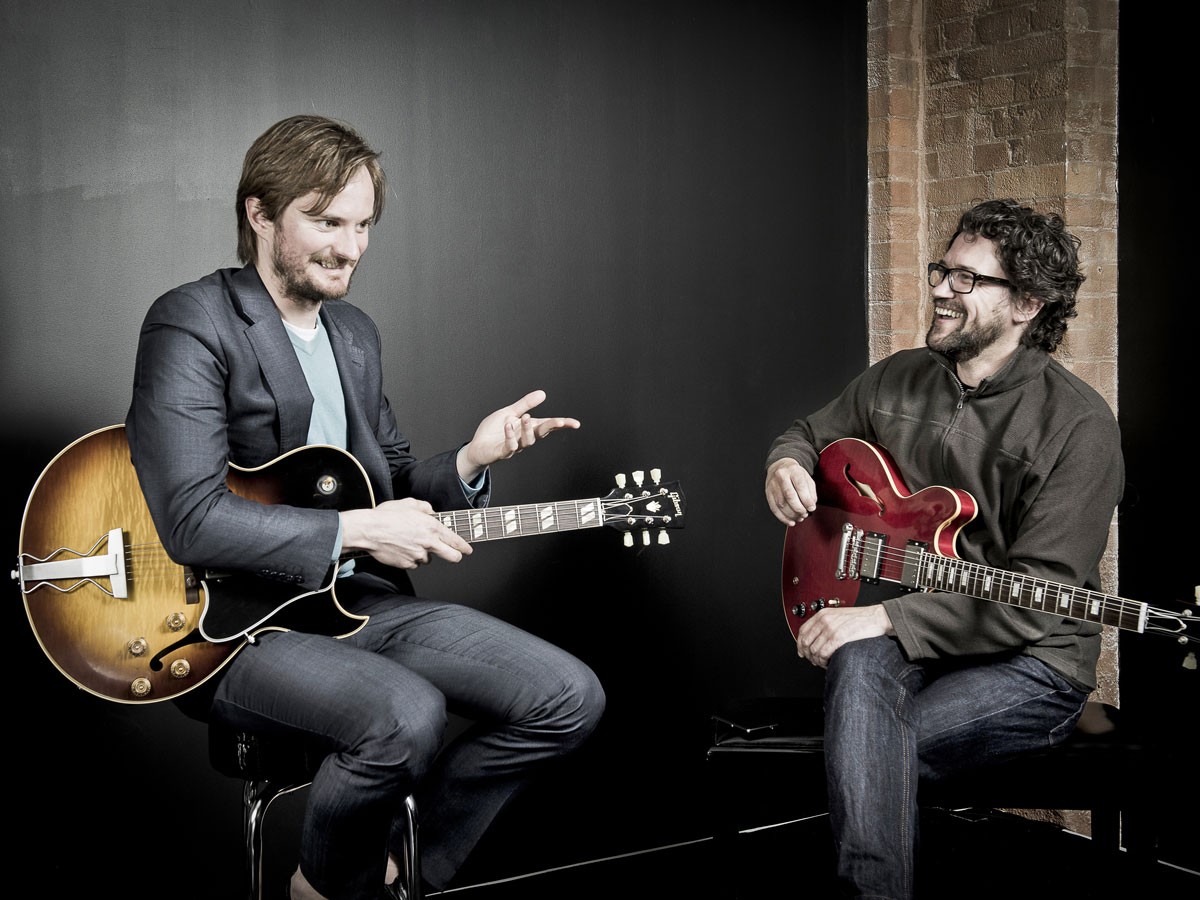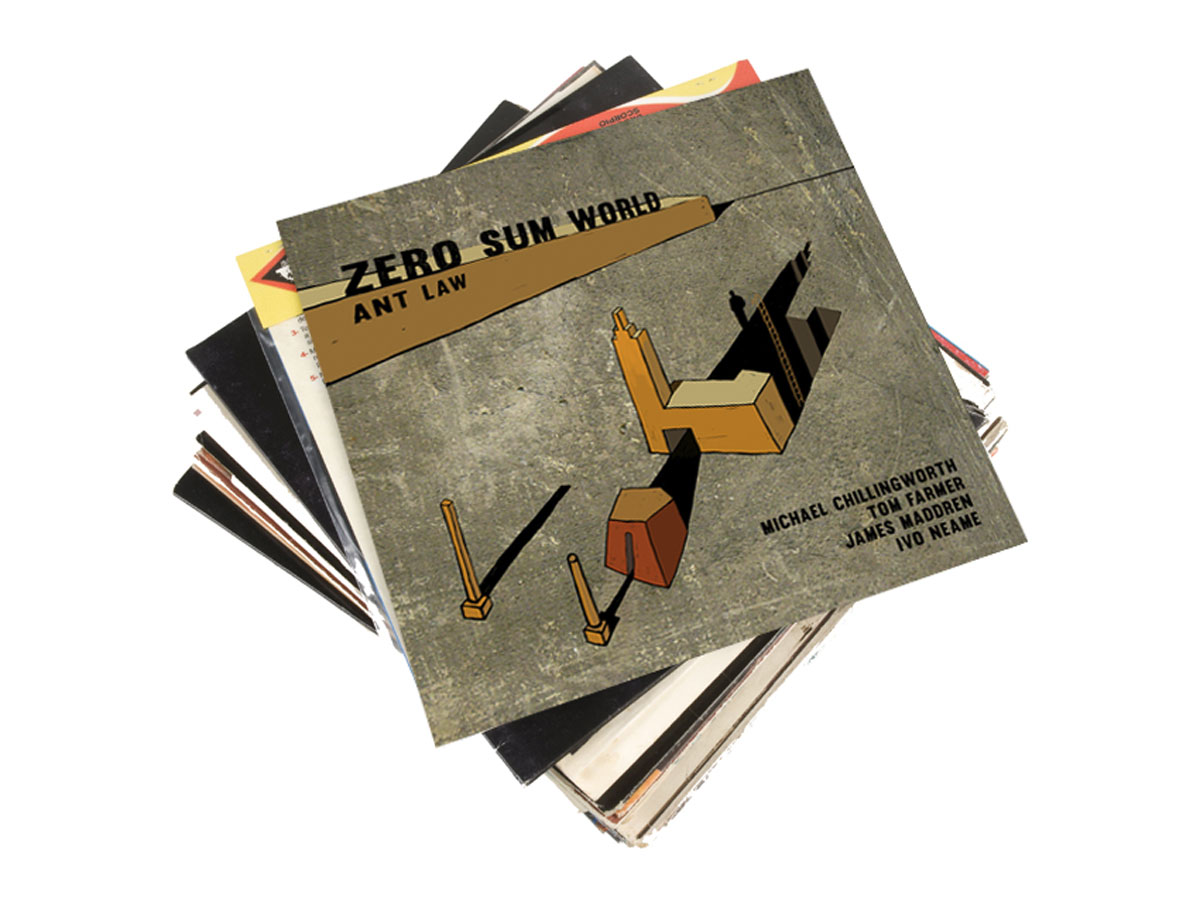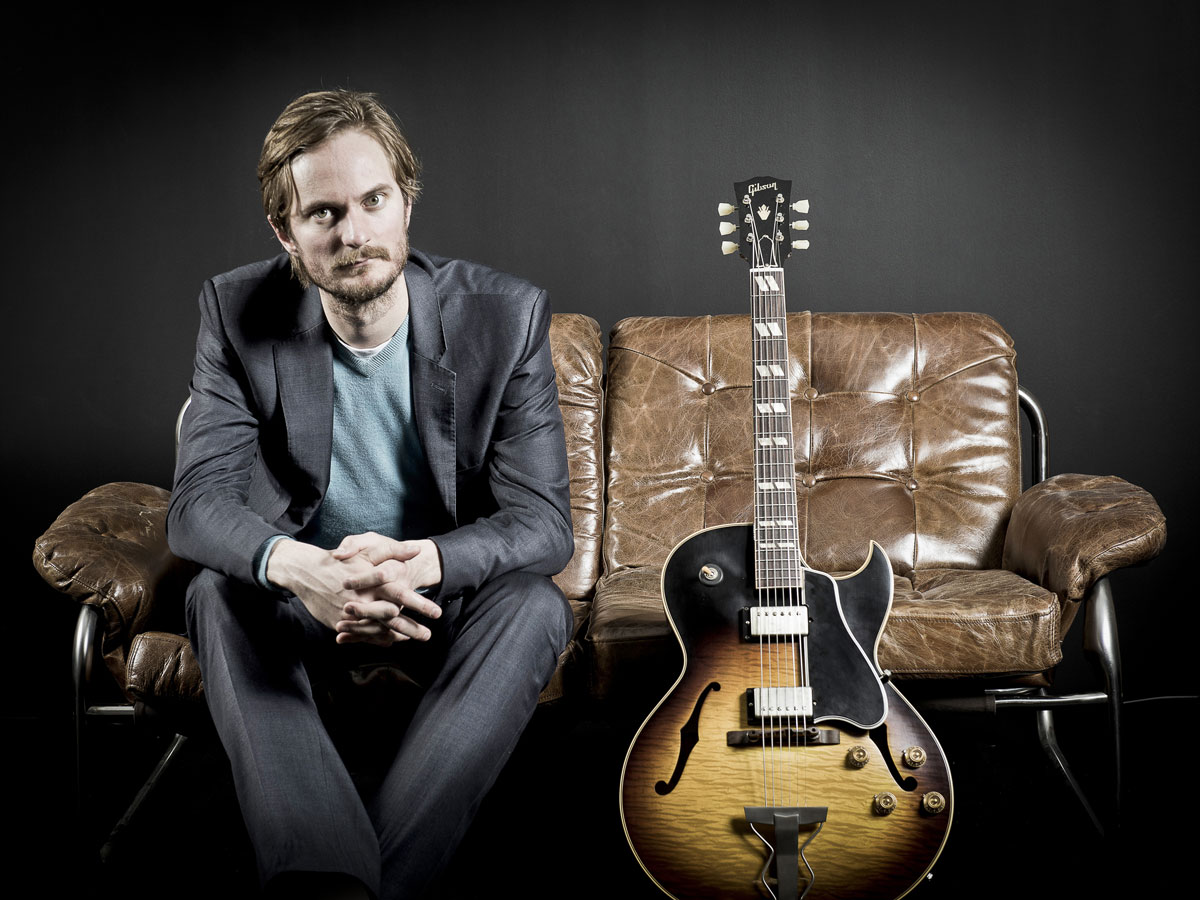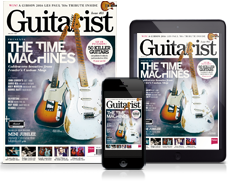Ant Law talks jazz guitar, SRV and Zero Sum World
We talk to the rising jazz star

Introduction
Ant Law's love of guitar was kick-started by SRV, bolstered by The Beatles and Stones, then shaped through classic blues, and the stadium rock and virtuosos of the 80s. It's an unconventional route to jazz, but one that has imbued the composer, touring artist and author's playing with a rare and captivating feel.
The recent release of his second album, Zero Sum World, confirms Ant Law's place as one of the most original jazz-guitar voices in a generation. Aside from writing, touring and recording with his own group, Law collaborates with a who's-who of the UK contemporary jazz scene and is also a published author. Guitarist caught up with the 32-year-old London resident to find out more about this rising star of jazz guitar.
How did you first become interested in guitar playing?
"I was born in the Middle East. Both my parents are English, but they were teaching in Saudi Arabia, and I lived there until I was 16. Growing up, I remember spending lots of time watching a video of Stevie Ray Vaughan's Live At The El Mocambo. I used to watch it every day."
"One thing that occurs to me about jazz guitar playing is that it can, sometimes, initially seem quite cold and sterile"
Was he your first influence?
"Absolutely. I remember hearing Scuttle Buttin' for the first time and thinking, 'Wow, this is the best thing that exists in the universe!'"
Hearing you play, one could be forgiven for being surprised that SRV would be an influence on you...
"Well, I feel that whenever I listen to Stevie Ray, whatever he plays, there is serious intention and force behind it. You really feel that he means something with every note. I don't get that feeling as much with some other players."
So, for you, it's beyond 'genre', it's more about an attitude to playing?
"Yes. Of course, if you really analyse SRV's music - with the exception of, say, Lenny or Riviera Paradise - you wouldn't call it jazz in terms of chord progressions and so on, so there isn't much 'parallel' with my music there, but as I said, his honesty and intention while playing was, and is, a huge influence.
"Also, his sound was so instantly recognisable. So many of us jumped on the bandwagon of Strat and Tube Screamer after hearing that tone, so that's also a factor that's important to me - having your own sound.
"One thing that occurs to me about jazz guitar playing is that it can, sometimes, initially seem quite cold and sterile. I remember listening to a jazz guitarist playing a melody [Ant plays an excerpt from the jazz standard It Could Happen To You, dead straight] with every note really clear and straight.
"By that time, I'd been listening to Steve Vai play [Ant plays the same thing à la Steve Vai, with slides into the notes and vibrato] and it made me wonder: 'Why wasn't the jazz player doing something with the notes to make them interesting?' But eventually I realised you can give the melody space. As in, it's okay if the melody isn't highly embellished - it's still a nice melody!"

Blues basis
Is that something you think guitarists struggle with due to the very nature of the instrument, as opposed to horn players who, naturally, have more scope to manipulate notes?
"I think the guitar falls somewhere between the piano and a horn. If there's a harmony competition, the piano is probably going to win. The instrument layout allows them to play far more chords and far more [laughs] 'expensive' chords than the guitar. But on the flipside, they can't get as much variation in the articulation of the notes. Horn players, however, can bend and manipulate single notes to a much greater degree, but they can't play chords.
"I think the guitar falls somewhere between the piano and a horn"
"So guitar is somewhere in the middle - you can play chords, but you can also vary the way you play notes. Oz Noy is a really intriguing dude; he plays very jazzily but there's also loads of cool guitaristic stuff going on. He mixes Thelonious Monk's piano style with Hendrix's phrasing and use of effects - you know, bending notes, lots of sustain, and such. But I do also like the sound of a really clean melody without any distractions."
In those early days, what else were you listening to apart from Stevie?
"I'd like to be able to say I grew up with jazz, but I didn't. My parents were listening to rock and pop, the Stones and The Beatles. My dad was really into blues and he'd tell me about John Lee Hooker and Muddy Waters.
"I've yet to meet a guitar player who doesn't enjoy blues. It's built into the instrument, I think. I was at a club in New York recently and the bandleader introduced the music, saying, 'We play jazz from the time when it still had blues in it,' which is an interesting point. Maybe some of it doesn't any more.
"If people don't like jazz, it's their loss. It's such a huge, rich tradition"
"After a while, I got really into Queen and Guns N' Roses. Then, being the 'geek' that I was, I got into Satriani and Vai. Listening to Steve Vai's playing, he does a very similar thing to John Coltrane. The textures that Vai creates with tapping were, to me, the same as Coltrane's 'sheets of sound' approach. That was my route into jazz."
How long had you been playing at that point, and were you taking lessons?
"I'd been playing since I was about 10, but at 14, I decided I wanted to be a 'real' guitar player. When I got to about 18, I had a jazz lesson and started to learn about the different kinds of chords and scales that jazz musicians use. I wasn't really listening to jazz at that point, but I thought if I learned it, it would make me better at rock!
"I guess I was trying to learn it without really listening to it. I soon realised that was a stupid idea. Then, after I started listening to Miles Davis and John Coltrane, I found I really liked it. If people don't like jazz, it's their loss. It's such a huge, rich tradition."

Zero Sum World
You've mentioned horn players as early jazz influences. At what stage in your development did you start listening to jazz guitarists?
"I've recently got a blend pedal, which means I can run my clean sound alongside my distorted one"
"Around the same time. Someone said, 'Check out Joe Pass and Wes Montgomery,' and I remember thinking it was all magic. At the back of my mind, though, I still wanted that Coltrane 'sheets of sound' thing on the guitar. Some guitar players like Allan Holdsworth or Tim Miller are doing that. It's something I'd like to develop more."
Listening to your new album, Zero Sum World, we're struck by your very modern approach to the guitar yet you play with almost an old-school classic jazz tone...
"I'm playing these days with saxophone, acoustic piano, upright bass and drums. Finding an electric guitar sound that blends with that has been a huge issue for me. I've recently got a blend pedal, which means I can run my clean sound alongside my distorted one - which has given me a more natural overdrive sound.
"Before, when I'd opt for a heavily distorted sound, it would feel like I was on a completely different wavelength from the rest of the band with all their lush, natural acoustic textures."
Do you think that's a hangover from the 'classic' era? The feeling that, if it's jazz, it has to be that Wes, Joe Pass clean tone?
"There are examples of contemporary players who do adhere to that, even guys that are playing really modern music, like Lage Lund or Adam Rogers, but you have other players like Kurt Rosenwinkel who seldom use a completely clean tone.
"I think we're at an interesting point now, but yes, there is definitely a way of thinking that says, 'I'm playing jazz so I have to have an archtop and play really clean with a little reverb.'
"At the studio, there was this small Marshall valve amp, which we were able to wind up to get a nice natural distortion out of"
"One problem for jazz players is if you're playing really lush, full chords, they can sound bad with even a little distortion, so the clean sound is more of a necessity to facilitate the extended harmony."
What's your go-to guitar and amp?
"I have lots of guitars and they're all great. But I've recently had a piezo pickup fitted to my Gibson ES-175, which I'm really excited about. My 175 is the guitar for me right now.
"On the album, I used it into a transistor amp and a valve amp in stereo à la George Benson. I had my Henriksen Jazz amp, which is really lush for that clean archtop stuff, and we just placed some ribbon mics in front of that. Then, at the studio, there was this small Marshall valve amp, which we were able to wind up to get a nice natural distortion out of."

Making it with Marshalls
A Marshall's probably the last amp you'd expect a jazz guitar player to plug in to!
"[Laughs] Well, it happened to be there, I tried it and it and it sounded nice. What I like now is to use my Polytone alongside a Fender '65 Twin reissue, then take a direct line out from the piezo. I also clip a DPA mic onto the guitar to get a bit of the room sound. That's how I would set up, in an ideal world."
You've got quite a combination of signals going on there...
"I am interested in weird rhythms like quintuplets or septuplets, which may, I hope, be an identifying feature of my playing"
"I think that's the way to go, because when you watch someone play live in a jazz club, Have guitars, will jazz - Ant and Denny trade licks and chew the fat for example, you hear much more than just the amp tone.
"You can hear their fingers on the guitar, which you don't get if you only hear the sound from the mic in front of the amp. You hear the guitar sound from the room itself. I try to capture as much of that as possible."
The big question: flatwound strings or round-wound strings?
"They're both great! It depends on what I'm doing. I love playing funk or Motown stuff on my ES-335 with flatwounds. Maybe that's what those guys were using back then? I like to change between flatwounds and round-wounds, it keeps it exciting. And it depends what tone I'm after at the time. I love the tone produced by the Dunlop Jazz III picks I use, the Ultex ones."
What do you feel is your voice on the guitar? What distinguishes you from all the other great guitar players out there?
"Oh, man! That's a tough one. Well, I'm not trying to be a guitar hero at all. I'm just trying to play nice melodies, most of the time. I am interested in weird rhythms like quintuplets or septuplets, which may, I hope, be an identifying feature of my playing.
"These are rhythms that aren't prevalent in any Western music - including jazz - but they're rudimentary in Indian music. My curiosity led me to study some of those rhythmic concepts. In fact, the fourth track on my album, Mishra Jathi, means 'sub-divided into seven', and the first track on my first album, Kanda Jath, means 'sub-divided into five'."

Tuned to perfection
You tune your guitar in perfect 4ths, leaving the top two at E and B with the rest tuned down a semitone - Gb, Db, Ab and Eb. How did you come to settle on that setup?
"Of course, you could leave the bottom four as they are and tune the top two up to C and F, which also gives you perfect 4ths across the neck. I guess I was searching for something. I had some jazz lessons and was given a stack of arpeggios to learn, and it frustrated me that I kept having to shift position and alter the fingering between the G and B strings.
"It's obviously quite ironic, but I read something on Steve Vai's website that said, 'Be an individual,' which inspired me to start experimenting with tuning"
"It's obviously quite ironic, but I read something on Steve Vai's website that said, 'Be an individual,' which inspired me to start experimenting with tuning. One thing is, it makes things easier because all the chord and scale patterns stay the same across the neck. I realised that, with a 4ths- tuned guitar, I only had to learn 33.3 per cent of what regular tuned guitarists have to learn!"
That sounds like a huge advantage! Are there any disadvantages?
"The 'open' CAGED chord shapes become really difficult. I should say that you get a great set of different open chords, though, Db, Gb, B and so on. But if you're playing those classic open-chord pop songs, or riffs in those 'white-note' keys, it's a pain. I was in a situation like that on a function gig, and someone called Long Train Running. That hammer-on minor 7th thing is pretty impossible with 4th tuning.
"Sweet Home Alabama also becomes the most virtuosic piece ever when you try to play it in D, in my tuning! But you'll actually find that there is a load of common repertoire that people get in the habit of transposing - Superstition, for example. Aside from that, having a 'uniform' neck with 4th tuning makes music on the guitar far more logical to me."
You've written a book on the subject - 3rd Millennium Guitar: An Introduction To Perfect 4th Tuning...
"Yes, I wrote it about five years ago and Mel Bay published it in 2011. I was on tour with the show Thriller Live! and spent some of my free time during the day putting the book together. As I said, 4th tuning makes things easier, and I thought it might catch on. Tom Quayle uses this tuning as does Stanley Jordan and many others. If you're curious, don't worry - it doesn't take that long to rewire the brain!"
Ant Law's latest album, Zero Sum World, is available now on Whirlwind Recordings.

